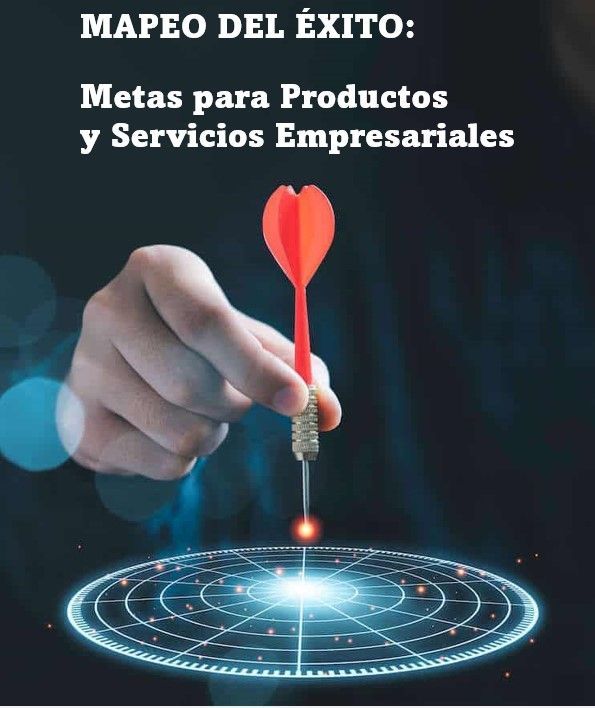Blog
Blog

Por laura.aveledo
•
29 de septiembre de 2024
Mapeo del Éxito: Cómo Establecer y Seguir Metas para Productos y Servicios Empresariales Laura Aveledo Business consultant | Advice on product management | Speaker and business trainer | Entrepreneur advisor | International business | CEO at Avexity International 10 de septiembre de 2024 Establecer y seguir metas claras es fundamental para el éxito de cualquier servicio. El tener un enfoque estructurado no solo ayuda a mantener la dirección en momentos críticos, sino que también asegura que todos los involucrados estén alineados con los objetivos generales de la empresa. Una meta sin un plan es simplemente un deseo.. Antoine de Saint Exupery Ya he hablado de que uno de los métodos más efectivos para establecer metas es el marco SMART: SPECIFIC MEASURABLE ACHIEVABLE RELEVANT TIME-BOUND Utilizando este método establecemos entonces la dirección a seguir para poder navegar con éxito el manejo de productos y servicios empresariales. 1. Establece Metas Específicas: "¿Qué queremos lograr?" Para que una meta sea efectiva, debe ser específica y clara. En lugar de fijar un objetivo general como "mejorar la satisfacción del cliente", define exactamente lo que eso significa para tu empresa. Por ejemplo, "incrementar la satisfacción del cliente en un 20% en los próximos seis meses mediante la mejora de tiempos de respuesta y la personalización de las interacciones". Tip: Desglosa metas grandes en pasos específicos y detallados; por ejemplo: introducir entrenamiento de personal, nuevos sistemas de automatización o encuestas de satisfacción al cliente. 2. Haz que las Metas Sean Medibles: "¿Cómo sabremos si hemos alcanzado nuestra meta?" Es esencial que ésta sea medible para seguir el progreso y saber cuándo has alcanzado tu meta. Esto implica definir indicadores clave de gestión (KPIs) que permitan medir el éxito. Siempre utiliza KPIS que sean claves y que midan lo que necesita para alcanzar tus metas. Tip: Utiliza herramientas de seguimiento y análisis que te permitan monitorear los KPIs en tiempo real, de modo que puedas ajustar tus estrategias si es necesario. Por ejemplo: un KPI podría ser el "índice de satisfacción del cliente (CSAT)" que se mide mediante encuestas post-servicio. 3. Asegúrate de que las Metas Sean Alcanzables: "¿Podemos lograr esta meta?" Las metas deben ser desafiantes, pero también alcanzables. Es crucial evaluar los recursos disponibles (personal, tiempo, presupuesto) antes de fijar una meta. Si no es así, ajusta la meta para que sea alcanzable. Tip: Realiza un análisis de capacidades y recursos antes de fijar metas. Por ejemplo: Evalúa tus capacidades y las de tu equipo para lograr un aumento del 20% en la satisfacción del cliente, de no ser posible, es preferible reducirla a 10 o 15%. 4. Define Metas Relevantes: "¿Esta meta es importante para nuestro negocio?" Una meta relevante está alineada con los objetivos generales de la empresa. Es importante que cada meta contribuya al éxito de tus productos y servicios, y que todos los esfuerzos contribuyan conjunta y directamente a ese éxito. Sino podrías estar perdiendo tu tiempo. Tip: Define una meta que afecta que impacte el éxito de un servicio. Por ejemplo: "reducir el tiempo de respuesta del servicio al cliente en un 30%". Esta meta es relevante porque una respuesta más rápida puede mejorar la satisfacción y, por ende, la retención de clientes. 5. Establece un Plazo para tus Metas: "¿Cuándo alcanzaremos esta meta?" Las metas deben estar limitadas en el tiempo para crear un sentido de urgencia y responsabilidad. Definir un plazo claro motiva a tu equipo a trabajar de manera más eficiente. Y motiva para conocer capacidades y tiempo pata lograrlo. Además, te ayuda a planificar para más adelante. Tip: Divide los plazos en hitos más pequeños para mantener a tu equipo motivado y para poder hacer ajustes si es necesario. Por ejemplo, en lugar de decir "mejorar el servicio al cliente", especifica "mejorar el servicio al cliente en un 15% en los próximos tres meses". Este plazo te permite planificar, asignar recursos y realizar seguimientos periódicos. "Tienen éxito, porque creen que pueden" ...... Virgilio El éxito de productos y servicios se logra teniendo una hoja de ruta cara y definida; el marco SMART para establecer y seguir metas, no solo guían a tu equipo, sino que también aseguran que los esfuerzos estén alineados con los objetivos estratégicos de la empresa. A través de la especificidad, la medición, la alcanzabilidad, la relevancia y la delimitación temporal, puedes asegurarte de que cada objetivo tenga un impacto positivo en el crecimiento y desarrollo de tus productos y servicios.

Por Laura Aveledo
•
27 de mayo de 2024
In my seminar on goal setting last week, we talked about SMART goals. The most important things is that Setting SMART goals is not enough… We need to have clear action plans, know obstacles, manage resources, and set priorities among many other considerations. Of the many businesses I have advised, and business plans I have reviewed, business goals were lacking in most of them. This is why I am a bit intense on setting goals that are right for your business, that will help when things get tough. Goals ARE an inspiration…. During the seminar, I was asked very interesting questions, some of them were: How do you know if my goals are achievable and realistic? First, is important to set the actions required to achieve that importa nt ?). These are actionable, smaller steps that can help determine if the goal is “doable” in the time frame you have set. Second, you need to set priorities, identify which step goes first and set an order in your actions to move forward. This will also help to realize if your goal is realistic (and in the desired timeframe). Can you run a pilot project related to your goal? This can help evaluate your goal before fully committing to it. There are many other things to consider (more on that next), but an important third point to consider is establishing milestones, keeping track and review. This is key for any business, even more for goal setting. Another excellent question was how do we know (and manage) our obstacles? We can’t predict the future, but we can surely estimate which obstacles will make it harder for us to achieve our business goals. For example, which are our limitations, in terms of time or capabilities? Do we have enough time and money to pursue our goals? What about health and skill obstacles? Can these affect you when dealing with clients, making decisions, and managing employees? Which activities are we investing time in that we shouldn’t be doing? (like social media??) We also know that changes in market conditions or economic downturns are potential obstacles, but these are risks that we can’t predict. It’s a matter of taking time to reflect and evaluate potential obstacles and, as I mentioned, the famous phrase from Game of Thrones, “ winter is coming, be prepared.” Set time to review potential obstacles and be prepared to deal with them. And this is a third and final question: taking to review and assess. As business owners, we tend to “go-go-go” and take little time to reflect. Establish a time in your calendar for feedback, so that you can monitor your progress. Take time to evaluate your performance against predetermined milestones. Even more, when we reach a goal, how do we know that we achieve our goal if we don’t take time to assess and evaluate your business? And that is a perfect excuse to celebrate, so take time to review, take time to assess and to celebrate when you have reached your goals! A LAST RECOMMENDATION: Write your goals! Maybe in a place where you can see them. Maybe in a place where you can place a checkmark when you have achieved them. Maybe in a place in your heart where you can celebrate success ! You can register here for my next goal setting seminar. Who is Laura? Laura is the Director of Avexity Internacional, she has an MBA, a master’s in marketing, and 25 years of international experience. Laura has advised 300+ business owners on planning and strategies for their business. These strategies help companies to create a strong business concept, develop new products and markets and increase revenues. Laura has worked with top financial and payment institutions, developing, and managing products and services, designing marketing strategies, and creating and implementing projects. Laura is a seminar speaker, she also trains business owners and taught Marketing, Entrepreneurship, and Management at university level. She also has authored business articles in Canada. Through Avexity International, Laura applies a “top-down” approach with her clients. You can contact me here .

Por laura.aveledo
•
19 de abril de 2024
Algo que me he encontrado en muchas ocasiones – quizás demasiadas – son aquellos emprendedores con un “GRAN” proyecto en mente”. Pero solo en mente. Cuando les pregunto los detalles de su negocio, pasan más de 5 minutos para poder explicar su proyecto, su idea, y la verdad es que es difícil seguirlos, por lo que tengo que hacer más preguntas para entender el proyecto o negocio. ¿Cómo puedes explicar tu negocio (y productos) a un cliente de manera clara y eficiente? Sabemos que retenemos muy poco en nuestra memoria… y si la explicación es muy compleja seguro que los clientes potenciales no van a recordar nada específico de tu negocio. Es muy importante poder expresar nuestros negocios, productos o servicios de manera clara y sencilla. Habiendo dictado muchos seminarios y talleres, sobre planificación de negocios, operaciones, mercadeo y toma de decisiones, ¡nunca me ha faltado mencionar la importancia de escribirlo TODO! Porque escribir es clave para tu empresa… ¿Y porque, es TAN importante escribirlo todo? Te invito a hacer un ejercicio: Cuando vas a un evento de networking y conoces a 10 personas, intercambian tarjetas y hablan un rato. ¿De cuantas personas, sus nombres y empresas/productos o servicios te acuerdas al día siguiente? Quizás de 1 o 2 con las que más hablaste, pero no más. Pero, si anotas los nombres, los temas de conversación o algún detalle que quedaste de enviarle, seguro lo vas a recordar al día siguiente. ¿Porque es tan importante escribir? Aquí van algunas razones Te concentras únicamente en tu actividad: Cuando escribes las cosas, te concentras solamente en esa actividad, es como si estuvieras utilizando una lupa para estudiar SOLO esa idea y concentrarte en ella, su forma, la luz, y además tienes que concentrar todas tus energías en escribir. Por otra parte, cuando solo pensamos en una idea (nuestras metas, por ejemplo), nuestros pensamientos van de una cosa a otra, se dispersan y cuando te das cuenta ya estás pensando en 5 ideas más, y muy diferentes y alejadas de la idea inicial. Organizas y priorizas tus ideas : Cuando escribes, tus ideas deben tener sentido ; además de concentración, necesitas entonces, organizarlas, ordenarlas por prioridad y confirmar que tienen sentido. Necesitas utilizar toda tu energía en eso, no hay tiempo ni energía para divagar… A veces nuestros sueños e ideas no tienen forma concreta en nuestra cabeza; lo mismo pasa con los objetivos y planes de nuestra empresa. ¡Hay que organizar y concretar! ¡Y es escribiendo que de verdad se logra el orden y sentido de las ideas! Recuerdas tus metas y planes: Cuando escribes tus metas y planes, mejoras tu capacidad de “recordarlas”, (efecto generación); eso que escribiste esta más afianzado en tu mente que una mera idea. Esta grabado. ¡así es más fácil recordarlo! Y no es solo recordar lo que escribes, es que la mente funciona de manera increíble, ya que lo escrito está grabado . Y es en ese proceso que se afianzan tus propósitos, pensamientos y acciones. Se vuelve como parte de tus intenciones, ¡está siempre presente! En conclusión, no solo es tener una idea, es importante escribirla para poder luego comunicarla y ejecutarla. En el próximo artículo, hablaré de tips para escribir tu plan de empresa. ... Y hablando de factores clave para tu empresa: Si estás en Málaga, dictaré un taller presencial (en inglés) sobre metas. Regístrate aquí: Spring Pivot Your Goals For 2024! Primavera es la época de florecer, perfecto momento para impulsar tus metas para el 2024. Apúntate aquí para el próximo taller de metas online: https://www.avexityinternational.com/contacto ¿Y quién es Laura? Laura es la directora de Avexity Internacional, tiene un MBA, un máster en marketing, y más de 25 años de experiencia internacional. Laura ha asesorado más de 300 clientes en sus planes y estrategias de negocios, y ha desarrollado estrategias para productos y servicios en banca, finanzas y proyectos de salud, entre otros. Laura es formadora y speaker en temas de emprendimiento, estrategias de marketing y gerencia de producto. Ha escrito artículos de negocios y ha sido entrevistada para artículos de negocios y emprendimientos en revistas internacionales. A través de Avexity Internacional, Laura aplica un top down approach para clientes:

Por Laura Aveledo
•
26 de junio de 2023
A high percentage of ventures fail because they don’t have a business plan, according to Laura Aveledo , business planning and international trade adviser at Small Business BC, a resource centre offering services, support and seminars for entrepreneurs. Aveledo gives us the short version of one of her courses 1. Start with a template “Most business plans start with an executive summary, and that’s the first thing that people need to see,” Aveledo says, “but that is done at the end.” A template should include sections covering the business concept; operations (processes, equipment, location, permits, risks); sales and marketing (pricing, differentiation from competitors, sales methods); management (who’s on the team and what they do); and financials (where the money comes from and when, how much funding you need). 2. Frame your business concept Outline what your product or service is and how you will provide it. What client pain do you resolve, and why would customers want that? Then research the details. What are industry trends, and what are competitors doing? How can you make your product different? Who are your clients, how much will they pay, and where do they live? Can you pay yourself a salary, and how much do you need to have in the bank at month’s end? “These are examples of questions that you have to ask yourself when you’re starting the business,” Aveledo explains. 3. Evaluate options Analyze the results of your research and decide what you can feasibly do. “Sometimes you know you want to provide a specific product or service, and then you find things that [make] you think, ‘These are not for me,’” Aveledo notes. Reject ideas if you feel they don’t make sense, be realistic, and compare alternatives. 4. Set goals Objectives could be the number of new clients you want to attract each quarter, sales contracts you expect to close per month or weekly likes on social media. You might want to institute a quality control program by a certain month or grow sales by 10 per cent in the next three months. Whatever they are, Aveledo stresses, “your goals should be SMART: specific, measurable, achievable, relevant and timely.” 5. Write the plan “Now you have the answers, you have your goals, so writing down the plan is much easier because you have made sense of things,” Aveledo says. “Be clear. Be precise. Be to the point.” Follow the template, then review what you’ve written. Ask someone unfamiliar with your plan to read it to make sure it’s easy to understand, Aveledo advises, adding that “no entrepreneur has ever done it alone.”

Por Laura Aveledo
•
14 de junio de 2023
We’ve all been tempted at some point in our lives. From watching your friend’s business flourish on Instagram and thinking, “I could do that,” to wanting to break out of the 9-to-5 lifestyle, entrepreneurship can be sparked in many ways. Once you’re ready to take that leap, it’s easy to want to dive right in and begin working on the exciting aspects of your business, without taking the time to work through the foundations. From the observation of past clients, entrepreneurs need to take the time to craft a healthy business plan with tangible resources, expert advice and support from within your community. Though this may seem obvious, too often the simplest advice is what goes unheard and ends up being a pivotal factor in reaching success further down the line. The past few years have seen an increase in women eager to be their own boss, with over 39% of all entrepreneurs that started businesses in 2018 identifying as female. I’m excited about this trend; however, I do still see that women are hesitant to reach out for assistance and need encouragement to go for the grants, clients, awards, etc. that they want. Here are some of my recommendations on where to begin your entrepreneurial journey: Have a clear business concept . A clear business concept enables you to quickly and clearly describe the exact nature of your business to suppliers, clients and potential investors. By doing this, you can manage client expectations and easily find new ways to differentiate your business within your industry to stand out from the crowd. Know your clients . The key is to know your ideal client inside out and understand that “everyone” is not an answer. You want to know as much as you possibly can about them – from what they need from you, to how they buy, to their favourite activities and everything in between. Once you know them, then you can communicate with them in a targeted approach, reaching them through the channels that they use daily. The more targeted you are, the more effective. Set SMART goals . Most of my clients come to me with a great idea but no plan to move it forward. SMART – specific, measurable, achievable, realistic and time-related – goal setting ensures that you are focusing your attention on development and growth in the areas of your business that need it, without getting distracted by other aspects that may not be relevant. For example, it doesn’t make sense to discuss what fantastic marketing campaigns you’re going to be running next year when you haven’t yet registered your business name. Plan for everything. Women tend to be great planners by design, but we still can’t predict the future. Have a contingency plan (and insurance) in place for dealing with the unexpected obstacles that will pop up in your business. You’ll feel more secure overall and be able to tackle issues effectively when they arise. Celebrate success . Make time to celebrate your wins. I always suggest that you take note of how much effort and time it took to reach each of your goals, so you have a benchmark for success moving forward. Whether you’re a “solopreneur” or have a team of 20, running a business is hard work, and you deserve to celebrate! Don’t be afraid. Don’t be afraid to move on from situations and people that are not helping you or your business to grow with purpose. Don’t fear asking questions or asking for the assistance you need to move forward. Prepare a strong business plan with structured goals and a realistic financial forecast, take a breath, then take a risk. At the end of the day, there is nothing more impressive than a confident woman owning her ambitions and creating a life and business that she is proud of. Laura Aveledo is one of the business planning and international trade advisers at Small Business BC. Originally from Venezuela, she has over 15 years of international experience, from large corporations to financial services and not-for-profits, in addition to developing her own business. She has advised more than 300 entrepreneurs from varied industry backgrounds and was an entrepreneurship instructor.

Por Laura Aveledo
•
14 de junio de 2023
As a business advisor, I meet with many entrepreneurs who have a clear business concept but they lack a clear definition of their target market. Many of my clients say that “everybody” is their target market. That statement is one of the most common mistakes new entrepreneurs make. Sticking to that thought will only lead to failed advertising, frustration and a botched product launch. The reality is that no product, no matter how popular or useful, will be liked by everybody. So, how do you make sure that you are selling to the right people? You need to clearly define your target market. It’s important to note, you aren’t stopping others outside your target market from buying from you. Instead, you are choosing to focus most of your efforts on a group that represents your “ideal customer”. You can have a primary and secondary target market, just make sure that you define them well. Still not convinced? Here are three reasons you should define your target market well: Product Description As a business owner, you need to tailor your product or service to your client’s needs. But how do you know their needs if you don’t know (in detail) who they are? Once you understand your target market, you can identify the product features they want and shape your offering to those needs. To give an example, if you are offering a service, you need to define the number of hours included and clearly present what the result will be. Try to think of the problems your ideal customer faces. How does your product answer those problems? Managing Expectations If you know what your clients want and you know what your product or service delivers, you can clearly explain to customers what the result will be. You can effectively manage their expectations, which will have a two-fold effect on your business. First, you will discourage customers who have unrealistic expectations of what you are offering. Secondly, you’ll be left with a satisfied pool of customers who will likely come back for more. Identifying Your Target Market Understanding your target market makes advertising to them all the easier. You should know what magazines or newspapers they read, what entertainment they consume, what social media channels they use, and most importantly – what moves them to buy. Based on your findings, you’ll be able to tailor messages to them that will resonate and leave a memorable impact in a crowded space. In our crowded media space, audiences don’t listen unless the message means something to them. Understanding your target market and pitching to them effectively has never been a more important skill for entrepreneurs.
Políticas de privacidad · Aviso Legal - © Avexity International - Creado con nubi.me



